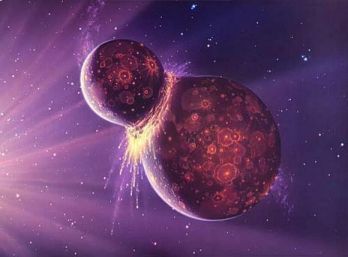This is a spectrometer into which basalt stones are inserted in a plasma state (in nature or in the laboratory) and the iron is separated into different isotopes. The scientists intend to use it to test rocks from the earth, stones from the moon and meteorites from various sources

One of the leading theories regarding the creation of the moon is the big collision theory, according to which a small planet about the size of Mars hit the earth in the early days of the solar system and caused the emission of huge amounts of hot materials from the outer layer of both bodies. This created a disk that surrounded the united Earth, materials that also eventually stuck together to form the Moon (at least those parts that didn't fall back).
Until recently, there was no way to test this theory, but a new instrument that examines the compositions of iron isotopes may give us insight into the origin of the Moon, as well as how Earth and the rest of the planets formed.
The new device plasma source mass spectrometer separates ions separates ions (charged particles) from a plasma source and examines their masses for the purpose of testing the iron isotopes. Examining the slight variation at the subatomic level could tell planetary scientists more details about the creation of the Earth's crust. This is what Nicholas Daups of the University of Chicago, Fang-Zen Teng of the University of Arkansas and Rosalind Helts of the US Geological Survey jointly wrote a study published in the journal Science.
Their findings contradict the popular belief that the isotope variation occurs only at relatively low temperatures and only in light elements such as oxygen, but Daufs and his colleagues were able to measure the isotope variation in the trend at a temperature of 1,100 degrees Celsius. Previous studies of basalt rocks found no separation in the iron isotopes, but these studies focused on the rock as a whole and not on a specific mineral. "We analyzed not only the whole rock but also each mineral separately" said Teng. "In particular, they analyzed the olivine crystals.
The ions are created at the end of the device in a plasma of argon gas at a temperature of about 7,800 degrees Celsius, hotter than on the surface of the sun. The device was tested on lava in the crater of the Gilaua volcano in Hawaii.
The device will test a variety of basalt rocks from Earth and beyond, including stones from the Moon and meteorites from Mars and asteroids. If successful, this method could provide unequivocal evidence for the big collision theory, and provide clues about the formation of the continents and perhaps even how other planets formed. "Our work opens up a new and fascinating line of research," says Daufs. "We can now use the iron isotopes as fingerprints of the creation of the trend and its diversification, two factors that play an important role in the formation of the continents.
